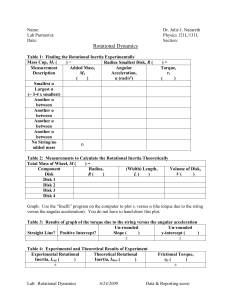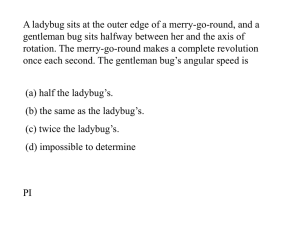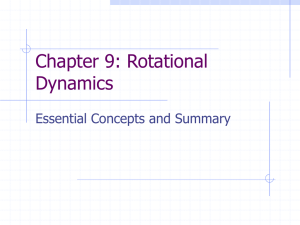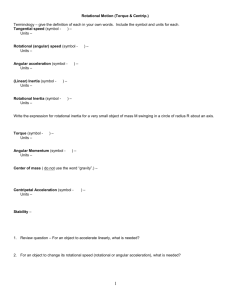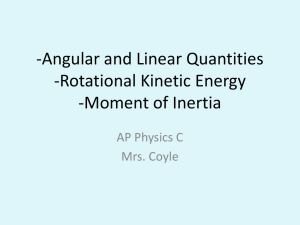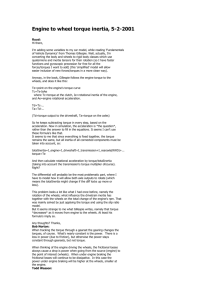Torque & MOI - Fulton County Schools
advertisement
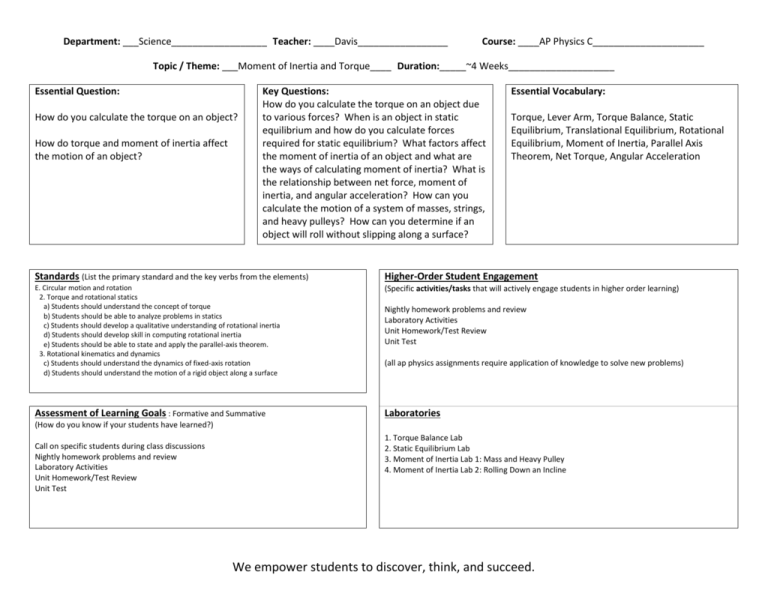
Department: ___Science__________________ Teacher: ____Davis_________________ Course: ____AP Physics C_____________________ Topic / Theme: ___Moment of Inertia and Torque____ Duration:_____~4 Weeks____________________ Essential Question: How do you calculate the torque on an object? How do torque and moment of inertia affect the motion of an object? Key Questions: How do you calculate the torque on an object due to various forces? When is an object in static equilibrium and how do you calculate forces required for static equilibrium? What factors affect the moment of inertia of an object and what are the ways of calculating moment of inertia? What is the relationship between net force, moment of inertia, and angular acceleration? How can you calculate the motion of a system of masses, strings, and heavy pulleys? How can you determine if an object will roll without slipping along a surface? Essential Vocabulary: Torque, Lever Arm, Torque Balance, Static Equilibrium, Translational Equilibrium, Rotational Equilibrium, Moment of Inertia, Parallel Axis Theorem, Net Torque, Angular Acceleration Standards (List the primary standard and the key verbs from the elements) Higher-Order Student Engagement E. Circular motion and rotation 2. Torque and rotational statics a) Students should understand the concept of torque b) Students should be able to analyze problems in statics c) Students should develop a qualitative understanding of rotational inertia d) Students should develop skill in computing rotational inertia e) Students should be able to state and apply the parallel-axis theorem. 3. Rotational kinematics and dynamics c) Students should understand the dynamics of fixed-axis rotation d) Students should understand the motion of a rigid object along a surface (Specific activities/tasks that will actively engage students in higher order learning) Assessment of Learning Goals : Formative and Summative Laboratories Nightly homework problems and review Laboratory Activities Unit Homework/Test Review Unit Test (all ap physics assignments require application of knowledge to solve new problems) (How do you know if your students have learned?) Call on specific students during class discussions Nightly homework problems and review Laboratory Activities Unit Homework/Test Review Unit Test 1. Torque Balance Lab 2. Static Equilibrium Lab 3. Moment of Inertia Lab 1: Mass and Heavy Pulley 4. Moment of Inertia Lab 2: Rolling Down an Incline We empower students to discover, think, and succeed. GPS Standards (Optional) I. Newtonian Mechanics E. Circular motion and rotation 2. Torque and rotational statics a) Students should understand the concept of torque, so they can: (1) Calculate the magnitude and direction of the torque associated with a given force. (2) Calculate the torque on a rigid object due to gravity. b) Students should be able to analyze problems in statics, so they can: (1) State the conditions for translational and rotational equilibrium of a rigid object. (2) Apply these conditions in analyzing the equilibrium of a rigid object under the combined influence of a number of coplanar forces applied at different locations. c) Students should develop a qualitative understanding of rotational inertia, so they can: (1) Determine by inspection which of a set of symmetrical objects of equal mass has the greatest rotational inertia. (2) Determine by what factor an object’s rotational inertia changes if all its dimensions are increased by the same factor. d) Students should develop skill in computing rotational inertia so they can find the rotational inertia of: (1) A collection of point masses lying in a plane about an axis perpendicular to the plane. (2) A thin rod of uniform density, about an arbitrary axis perpendicular to the rod. (3) A thin cylindrical shell about its axis, or an object that may be viewed as being made up of coaxial shells. e) Students should be able to state and apply the parallel-axis theorem. 3. Rotational kinematics and dynamics c) Students should understand the dynamics of fixed-axis rotation, so they can: (2) Determine the angular acceleration with which a rigid object is accelerated about a fixed axis when subjected to a specified external torque or force. (5) Analyze problems involving strings and massive pulleys. d) Students should understand the motion of a rigid object along a surface, so they can: (1) Write down, justify, and apply the relation between linear and angular velocity, or between linear and angular acceleration, for an object of circular cross-section that rolls without slipping along a fixed plane, and determine the velocity and acceleration of an arbitrary point on such an object. (2) Apply the equations of translational and rotational motion simultaneously in analyzing rolling with slipping. We empower students to discover, think, and succeed.

